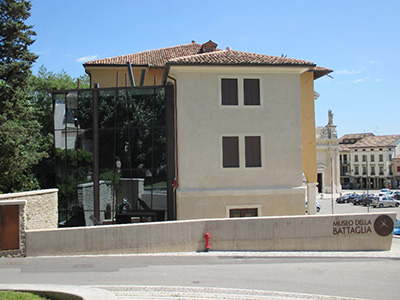A museum commemorating the World War I battle of Vittorio Veneto in North-East Italy has been extended and renovated with support from EU funding. The project also entailed modernising the museum’s interior layout to meet the expectations of a broader audience, especially students.
Vittorio Veneto World War I museum extended and renovated
- 06 September 2018
The Museo della Battaglia achieved high quality standards appropriate for the enhancement of the museum’s structure thanks to a complex restoration activity and an innovative arrangement project, both museographic and museological, which contributed to improving World War I museums and the entire museum system in the Veneto.
The renovation and extension project was launched as part of a drive to meet the needs of the Veneto region, in which Vittorio Veneto is located, in terms of provision of museums developed in line with modern museology standards.
At Vittorio Veneto, this was achieved through the architectural restoration of the building and further structural work, as well as the creation of new display arrangements and thematic areas on different floors as part of a general rationalisation of the museum’s spaces.Other elements of the work included a new entrance and management area, new access systems, modernisation of the building’s energy systems with a view to limiting consumption, and the setting up of an interactive multimedia laboratory.
A local museum for an event of global significance
Situated in the province of Treviso, in the foothills of the Alps, Vittorio Veneto was the scene of a battle fought from 24 October to 4 November 1918. The Italian victory marked the end of World War I on the Italian Front and contributed to the armistice of 11 November 1918 that ended all fighting in the war.
Founded in 1938, the Museo della Battaglia (Museum of the Battle) has long retained a local and private air due to its small size. For much of its history, its collections have been enriched by donations.
Consisting of three adjoining buildings, of which the Palazzo Ceneda constitutes the main part, the museum complex was built during 1536-37. The construction followed a master plan traditionally attributed to prominent architect Jacopo Sansovino.
Emphasising the theme of the museum
The new layout is designed to fully emphasise the theme of the museum while preserving the most important features of the original arrangement. A combination of shapes, light, sound, colours, materials, and still and moving images are integrated into a single narrative thread.
The ground floor focuses on life in the trenches. A winding path consisting of a streamlined reproduction of a trench shows visitors how soldiers spent their time there. It attempts to convey some of the sensations they experienced, from military issues to personal matters such as free time and correspondence with loved ones. Belongings, letters, books and films, as well as smells, sounds and visual effects give insights into a little-known reality.
On the first floor, three rooms are dedicated to the lives of civilians and the 1917-18 Austro-Hungarian occupation of Friuli and eastern Veneto, with one room containing a reconstruction of a building ransacked during the occupation. The path continues with drawers and doors hiding written and visual materials. Finally, the second floor is dedicated to the battle itself.
In 2018, the museum is hosting part of the programme linked to the 100th anniversary commemorations of the end of World War I and events for the European Year of Cultural Heritage.
Total investment and EU funding
Total investment for the project “Reclamation of the World War I Vittorio Veneto Battle Museum – Vittorio Veneto (Treviso)” is EUR 2 827 000, with the EU’s European Regional Development Fund contributing EUR 793 473 through the “Veneto” Operational Programme for the 2007-2013 programming period.

